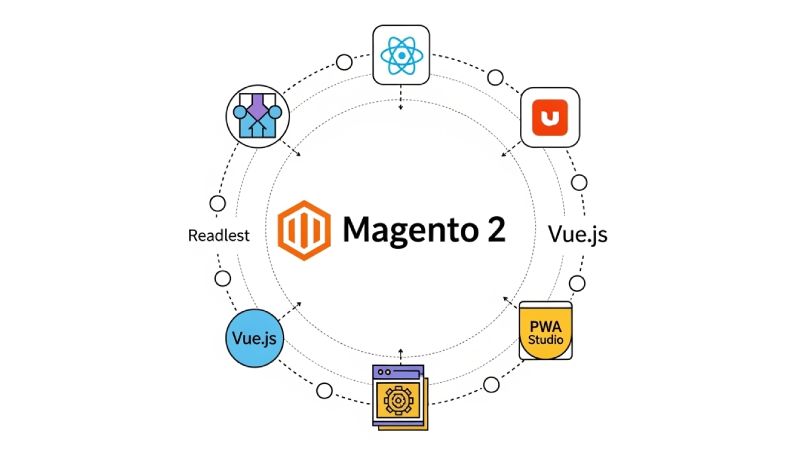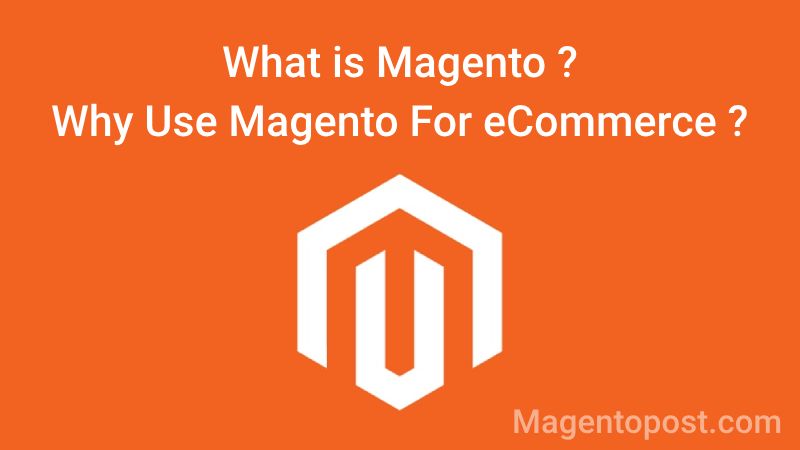
Best Headless Technologies Used For Magento 2
For Magento 2, headless architecture is a powerful approach that separates the frontend (what users see) from the backend (where data and logic are managed). This decoupling offers significant benefits, including improved performance, greater flexibility in design, and omnichannel capabilities.
When you talk about Magento 2 (now Adobe Commerce) in a headless setup, you’re essentially using Magento only as a backend (for catalog, checkout, orders, etc.) and building your frontend separately with modern technologies.
Here are some of the best headless technologies commonly used with Magento 2:
Frontend Frameworks/Libraries:
- React.js:
- Why it’s popular: React is a widely adopted JavaScript library for building user interfaces. It’s component-based, uses a virtual DOM for faster rendering, and has a large community with extensive resources.
- Benefits for Magento 2: Allows for highly interactive and dynamic storefronts, improved page load speeds (especially with techniques like server-side rendering), and strong support for single-page applications (SPAs) and Progressive Web Apps (PWAs).
- Frameworks built on React:
- Next.js: A React framework that offers server-side rendering (SSR) and static site generation (SSG), crucial for SEO and initial page load performance. It’s excellent for building fast, flexible Magento storefronts.
- Gatsby: A static site generator built on React and GraphQL. It’s ideal for content-heavy or catalog-driven Magento stores where speed and SEO are top priorities, as it pre-renders pages at build time.
- Vue.js:
- Why it’s popular: Vue.js is a progressive JavaScript framework known for its gentle learning curve, flexibility, and strong performance. It’s also component-based and uses a virtual DOM.
- Benefits for Magento 2: Great for building custom, mobile-first Magento storefronts. It supports two-way data binding for real-time interaction and works well with REST or GraphQL APIs.
- Frameworks built on Vue.js:
- Vue Storefront: An open-source, headless e-commerce frontend framework built specifically with Vue.js. It’s designed to connect with various e-commerce platforms, including Magento 2, and focuses on creating fast, smooth-loading Progressive Web Apps (PWAs).
Magento-Specific Headless Solutions (often built with the above frameworks):
- PWA Studio (Adobe Commerce PWA Studio):
- What it is: Adobe’s official toolkit for building Progressive Web Apps (PWAs) on Magento 2. It’s built using React and GraphQL.
- Benefits: Provides an app-like experience with features like offline support and push notifications. It offers a Venia storefront as a starting point and supports modular development.
- Note: While it’s an official solution, there’s a growing trend towards simpler alternatives like Hyvä Themes due to PWA Studio’s complexity and Adobe’s shifting focus.
- ScandiPWA:
- What it is: A plug-and-play Progressive Web App theme for Magento 2. It installs directly on top of Magento without requiring extra services.
- Benefits: Supports all native Magento features, including checkout and layered navigation, offering a quick way to implement a PWA.
- Hyvä Themes + Custom API Layer (a near-headless approach):
- What it is: Hyvä Themes focuses on simplifying the Magento frontend by eliminating heavy JavaScript libraries and using lightweight technologies like Alpine.js and Tailwind CSS. When paired with a custom API layer, it acts as a very performant, almost headless solution.
- Benefits: Offers significantly faster Magento frontend performance, reduced development complexity, and lower maintenance costs compared to full headless implementations.
Headless CMS (Content Management Systems):
While Magento handles product data, a headless CMS can be integrated for managing richer content like blog posts, landing pages, and marketing materials. This allows marketing teams to update content independently of the core e-commerce system. Popular choices include:
- Contentful
- Strapi
- Sanity
Why go headless with Magento 2?
- Improved Performance: Faster page load times, smoother user experience, and better Lighthouse scores due to lightweight frontends and optimized data fetching.
- Enhanced Flexibility and Customization: Complete control over the frontend design and user experience, allowing for unique brand identity and rapid UI/UX changes without impacting the backend.
- Omnichannel Capabilities: Easily deploy content and commerce experiences across various touchpoints (web, mobile apps, in-store kiosks, IoT devices) from a single Magento backend.
- Scalability and Future-Proofing: Easier to adopt new technologies, integrate third-party services, and scale independently for frontend and backend.
- Improved SEO: More control over frontend elements, leading to better optimization for search engines.
- Developer Productivity: Frontend and backend teams can work concurrently, accelerating time-to-market.
The best choice depends on your specific project requirements, budget, team expertise, and desired level of customization and performance.

